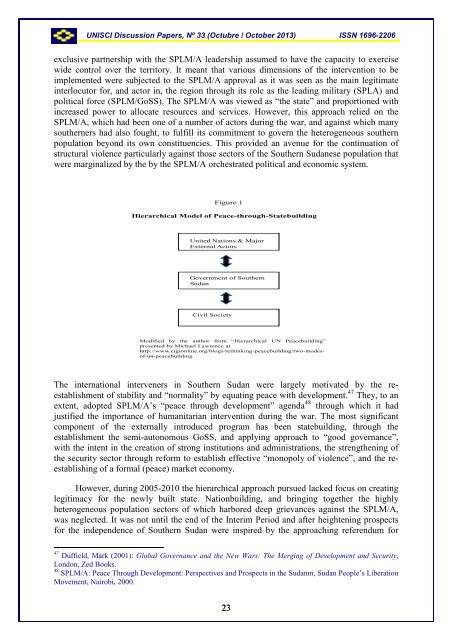UNISCI - Universidad Complutense de Madrid
UNISCI - Universidad Complutense de Madrid
UNISCI - Universidad Complutense de Madrid
Create successful ePaper yourself
Turn your PDF publications into a flip-book with our unique Google optimized e-Paper software.
<strong>UNISCI</strong> Discussion Papers, Nº 33 (Octubre / October 2013) ISSN 1696-2206exclusive partnership with the SPLM/A lea<strong>de</strong>rship assumed to have the capacity to exercisewi<strong>de</strong> control over the territory. It meant that various dimensions of the intervention to beimplemented were subjected to the SPLM/A approval as it was seen as the main legitimateinterlocutor for, and actor in, the region through its role as the leading military (SPLA) andpolitical force (SPLM/GoSS). The SPLM/A was viewed as “the state” and proportioned withincreased power to allocate resources and services. However, this approach relied on theSPLM/A, which had been one of a number of actors during the war, and against which manysoutherners had also fought, to fulfill its commitment to govern the heterogeneous southernpopulation beyond its own constituencies. This provi<strong>de</strong>d an avenue for the continuation ofstructural violence particularly against those sectors of the Southern Sudanese population thatwere marginalized by the by the SPLM/A orchestrated political and economic system.Figure 1Hierarchical Mo<strong>de</strong>l of Peace-through-StatebuildingUnited Nations & MajorExternal ActorsGovernment of SouthernSudanCivil SocietyModified by the author from “Hierarchical UN Peacebuilding”presented by Michael Lawrence athttp://www.cigionline.org/blogs/rethinking-peacebuilding/two-mo<strong>de</strong>sof-un-peacebuildingThe international interveners in Southern Sudan were largely motivated by the reestablishmentof stability and “normality” by equating peace with <strong>de</strong>velopment. 47 They, to anextent, adopted SPLM/A’s “peace through <strong>de</strong>velopment” agenda 48 through which it hadjustified the importance of humanitarian intervention during the war. The most significantcomponent of the externally introduced program has been statebuilding, through theestablishment the semi-autonomous GoSS, and applying approach to “good governance”,with the intent in the creation of strong institutions and administrations, the strengthening ofthe security sector through reform to establish effective “monopoly of violence”, and the reestablishingof a formal (peace) market economy.However, during 2005-2010 the hierarchical approach pursued lacked focus on creatinglegitimacy for the newly built state. Nationbuilding, and bringing together the highlyheterogeneous population sectors of which harbored <strong>de</strong>ep grievances against the SPLM/A,was neglected. It was not until the end of the Interim Period and after heightening prospectsfor the in<strong>de</strong>pen<strong>de</strong>nce of Southern Sudan were inspired by the approaching referendum for47 Duffield, Mark (2001): Global Governance and the New Wars: The Merging of Development and Security,London, Zed Books.48 SPLM/A: Peace Through Development: Perspectives and Prospects in the Sudanm, Sudan People’s LiberationMovement, Nairobi, 2000.23
















